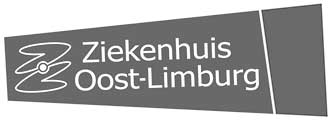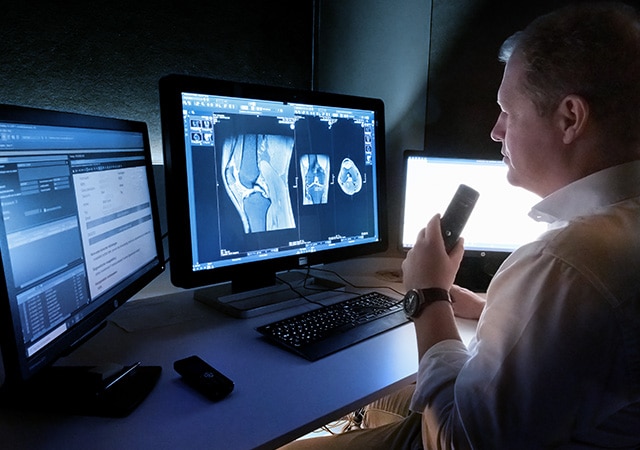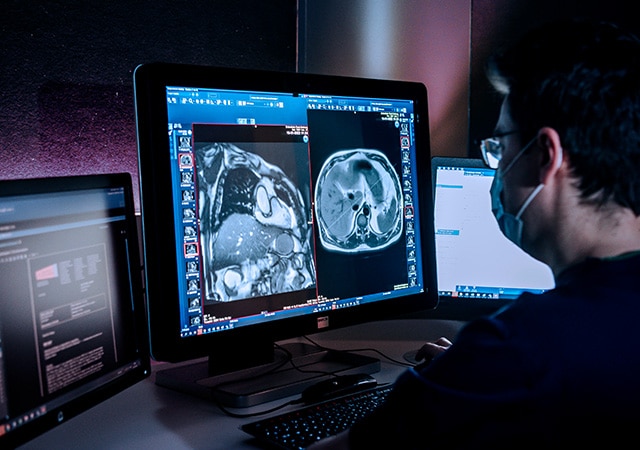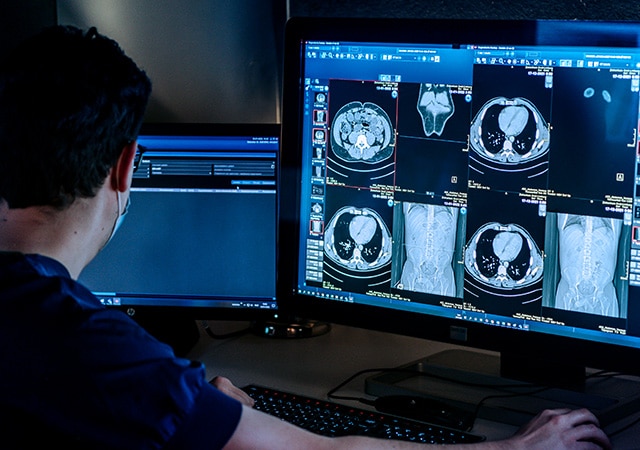Customer Case Study
Ziekenhuis Oost-Limburg (ZOL), Maaseik

Human skill and teamwork, combined with the newest devices and IT, provide excellent care quality and patient experience
Medical Imaging at Belgian hospital Ziekenhuis Oost-Limburg transforms itself into a modern, well-respected, tertiary care center
The Medical Imaging department at Ziekenhuis Oost-Limburg (ZOL) has experienced a major transformation on all fronts over the past few decades.
The department has grown exponentially, all four sites have undergone numerous renovations, and the 30 on-staff radiologists have become specialists in a wide range of disciplines. High-tech scanners and other equipment as well as the most modern IT solutions have been implemented.
“The bar has been set very high, because we want to offer our patients both the best possible care and a good patient experience,” explains Bruno De Peuter, Head of the Medical Imaging department at ZOL.

Dr. Bruno De Peuter
Head of Medical Imaging and Musculoskeletal Radiology
Specialist Oost-Limburg Hospital
Investing in people and technology
With 30 radiologists, the department is one of the largest in Belgium. But quantity is not the only concern – quality is even more important. As Dr. De Peuter says, “We have always been very committed to quality. That means we strive to attract the best people in all disciplines – both in terms of their personality and their skill sets.”
“We also believe that everyone deserves a pleasant work environment; after all, you spend a lot of time there. That was the driver for the many renovations and rebuilding works. In Medical Imaging, we have also invested in the latest equipment. For example, we were one of the first in Belgium to install a dual-source CT scanner. And for data storage and viewing, we work with the latest IT systems. This all costs money, but these systems allow us to work much faster.”
30
radiologists
4
sites
45.000+
MRI scans per year
Centralized worklists for efficient teamwork
For many years, ZOL has relied on AGFA HealthCare for PACS and RIS, and was one of the first hospitals in Belgium to upgrade to Enterprise Imaging. Dr. De Peuter explains, “This new platform offers us many advantages, and helps us to create a comprehensive departmental structure. We’ve set it up so that we can work very efficiently, even though we have a large team.”
“Based on queries, we can create separate, cross-site worklists for each of the subspecialties. Regardless of which ZOL site performs the exam, everything ends up in the central list, nice and tidy. If I, as a musculoskeletal radiologist, am working with MRI, I simply open the appropriate list and I can start reading. I know exactly what to do, without having to open four or five different lists.”
“The result is that as a team we can read many more exams than before. The exams are also completed much faster, and none of them slip through the net. For the radiologists, the big advantage is that the workload is divided up much more equitably.”
“We have noticed that homework increases our efficiency significantly. It used to take six to eight radiologists to read 250 MRIs over the weekend; now, we can do it with only five!”
Standardized work and priorities
“I also think it is important that when you open up an exam, the images for each subspecialty are displayed in a standardized way,” says Dr. De Peuter. “We discussed this with our colleagues, and then set it up the way we wanted it, using the rules-based engine from Enterprise Imaging. Images are now available very quickly, and there are fewer technical issues that require intervention from the IT Department.”
The ability to prioritize exams within the work lists is another handy functionality. Patients in the Emergency Departments are color-coded red, for example, while those in the ICU are coded orange, and outpatients whose GP needs a report immediately are coded yellow. This lets the radiologists know which exams to do first, without losing valuable time.
From three to four sites – smooth upscaling
In the midst of the Covid-19 pandemic, ZOL also merged with the Maas and Kempen hospital in Maaseik. Adding this fourth site had far-reaching consequences for the imaging department.
“We were able to quickly scale up our Enterprise Imaging installation in order to integrate the site in Maaseik into our environment,” Dr. De Peuter continues. “The radiologists in Maaseik found it relatively easy to master Enterprise Imaging and to work within the larger ZOL environment. After a few afternoons of training, they were on their way. We were very satisfied with the training and the guidance provided by AGFA HealthCare.”
“During change processes like these, our key words are communication, transparency and team-building. If you communicate clearly and transparently, you can prevent a lot of resistance to change. This recipe has proven successful many times here. But it also helps that Enterprise Imaging – despite its comprehensive functionality – is intuitive to work with. I notice this time and again, especially when I read exams that are outside my usual scope. I wouldn’t want to return to the former PACS.”

Home reporting – doing more with fewer people
Enterprise Imaging also provides radiologists with the perfect home working environment. Bruno De Peuter describes, “Long before the Covid-19 outbreak, we were the first hospital to work out a home-reporting set-up, together with AGFA HealthCare. Initially, our aim was to give a particular sick colleague a pleasant and safe way to work from home. Unfortunately, our colleague has since passed away, but we were able to use the learnings from the experience for the advantage of the department.”
During the Covid-19 lockdowns, ZOL organized itself to enable the majority of its radiologists to work from home. Now, almost each one has a workstation at home. These stations are identical to those in the hospital, and have the same specifications and functionalities. If technical problems arise, IT can log in and fix the problem, just as in the hospital.
“We are still working partly from home today,” says Dr. De Peuter. “We have noticed that homework increases our efficiency significantly. It used to take six to eight radiologists to read 250 MRIs over the weekend; now, we can do it with only five!”
“Considering the increasing shortage of radiologists, I expect that in the future we will use more external radiology consultants, who will also benefit from this set-up. Either way, remote working is here to stay.”
“The Mobile Image Capture platform needed to be easy to use, while providing the and security our patients count on.”
Dr. Paul Eleftheriou
Deputy Chief Medical Officer and Director of Quality and Safety
Strengthening our ties to referrers
The satisfaction of referring physicians, both internal and external, is important to Dr. De Peuter. Each has access to the results (images and reports) of the exam performed on their patients. They receive quick assistance for any questions, as well.
While the radiologists can work and communicate withcolleagues remotely from home (including via Microsoft Teams), Dr. De Peuter still believes that they should be accessible and approachable, preferably in the hospital – to make themselves indispensable to their colleagues.
That is why the department has put so much focus on developing subspecialties. “We must continue to prove that we are more skilled at looking at images than a surgeon in an academic hospital who only performs hip operations. That is our added value as radiologists,” says Dr. De Peuter.
“For this reason, I also encourage our radiologists to actively participate in multidisciplinary team meetings, such as oncology consultations. That is where you meet the colleagues who, after all, make referrals.” Dr. De Peuter and his colleagues further strengthen their ties with referrers by transparently explaining how their department works.
Management based on Business Intelligence
“My favorite module within Enterprise Imaging is Business Intelligence (BI),” continues Dr. De Peuter. “I steer the entire department from there. On a nearly daily basis, I request figures on the number of exams – CTs, ultrasounds, etc. – performed. For example, if six radiologists report that ultrasound is too busy, I can call up the numbers and determine where the bottleneck is.”
Dr. De Peuter uses the monthly reports to maintain an overview. “If I notice that a figure deviates from the normal usage stats, I will dig deeper to determine the cause of the deviation and how we can correct it. For example, at our Sint-Jan site, we noticed that only 50% of the women eligible for breast cancer screening are participating. But the participation percentage is higher at the smaller sites. We are now looking into whether we can increase participation by moving breast cancer screenings to small, accessible campuses, like André Dumont.”
“Another example is scheduling MRIs at night. For the patients, this is a significant improvement, because the additional capacity drastically reduces waiting times. But for the nursing team, night work means more pressure. We can use the BI module to monitor how the waiting times are evolving on a daily basis. If we notice, for example, that the waiting times for back exams are shorter than four weeks, we can pause night exams for a while. These are all examples of ways we use BI to manage the department.”

Digitization of requests
Currently, ZOL is working hard to digitize imaging orders. The Belgian government wants radiologists to pre-screen requests to confirm that the appropriate exams have been ordered.
This can help eliminate duplicate examinations (e.g., CT and MRI) reducing unnecessary government expenditures. But if patients only submit their (paper) requests when they come to the hospital for the exam, it is too late to make adjustments.
50% of imaging requests are now received in advance and digitally, via the electronic patient record, but Dr. De Peuter wants to increase this to 90%: “We encourage GPs to send us their digital requests.
We have also built a patient website, where patients can easily book an appointment for a radiology exam and upload a photo of the paper request.
They can also specify a time for us to contact them by phone to confirm the appointment, and to schedule the most suitable location. This is very handy for the patients, and for our team, because we have the correct patient data straightaway, and can provide the right care in the right place.”
Artificial Intelligence – absolute added value for radiologists
This year, ZOL aims to start using AI on a large scale, says Dr. De Peuter. “AI has huge potential: it’s a technology that radiology absolutely must embrace.”
For data protection reasons, ZOL has chosen not to have images analyzed in the cloud. ZOL is working with some other hospitals to see whether forming a network could reduce the cost associated with acquiring AI software and paying per analysis.
At the top of ZOL’s wish list is AI for chest X-rays and mammography. Currently, mammograms are checked by two doctors at ZOL and then by a third at University Hospitals Leuven. The AI system could, for example, automatically identify mammograms that require a second reading. “That would save us a lot of time,” explains Dr. De Peuter. “We would like to work with AGFA HealthCare’s RUBEE packages. The big advantage of these packages is that they are completely embedded in the Enterprise Imaging work processes. That definitely adds value compared to other packages that are stand-alone.”

Did you know that…?
… Ziekenhuis Oost-Limburg (ZOL) has four locations.
… Ziekenhuis Oost-Limburg (ZOL) has four locations.
Campus Sint-Jan focuses on tertiary medical imaging, while the other three campuses offer mainly primary care services.
By providing the right care in the right place, the hospital can combine quality with an excellent, easily accessible patient experience
… Every radiologist that comes to work at ZOL can receive financing to train abroad within their subspecialty.
… Every radiologist that comes to work at ZOL can receive financing to train abroad within their subspecialty.
That way, young radiologists starting at ZOL bring new and enriching insights, which are then often implemented at the hospital. For example, the hospital recently started a “one-stop shop” for mammography. Instead of an isolated examination, mammography is now considered part of a complete care process. Patients with a lump in their breast can start treatment sooner, which also eases their concerns.
… In addition to the RIS and PACS, the radiologists at ZOL also make comprehensive use of the electronic patient record.
… In addition to the RIS and PACS, the radiologists at ZOL also make comprehensive use of the electronic patient record.
This allows them to assess a patient’s images within the context of a larger framework – a holistic approach to the patient, so to speak.
